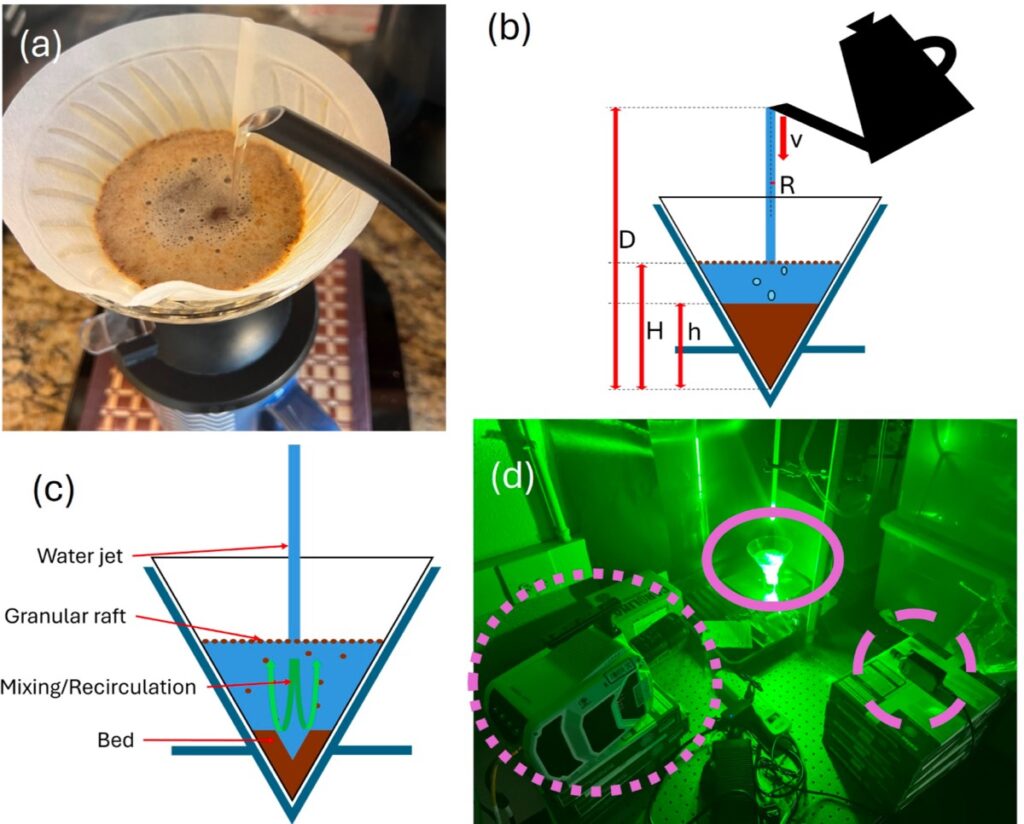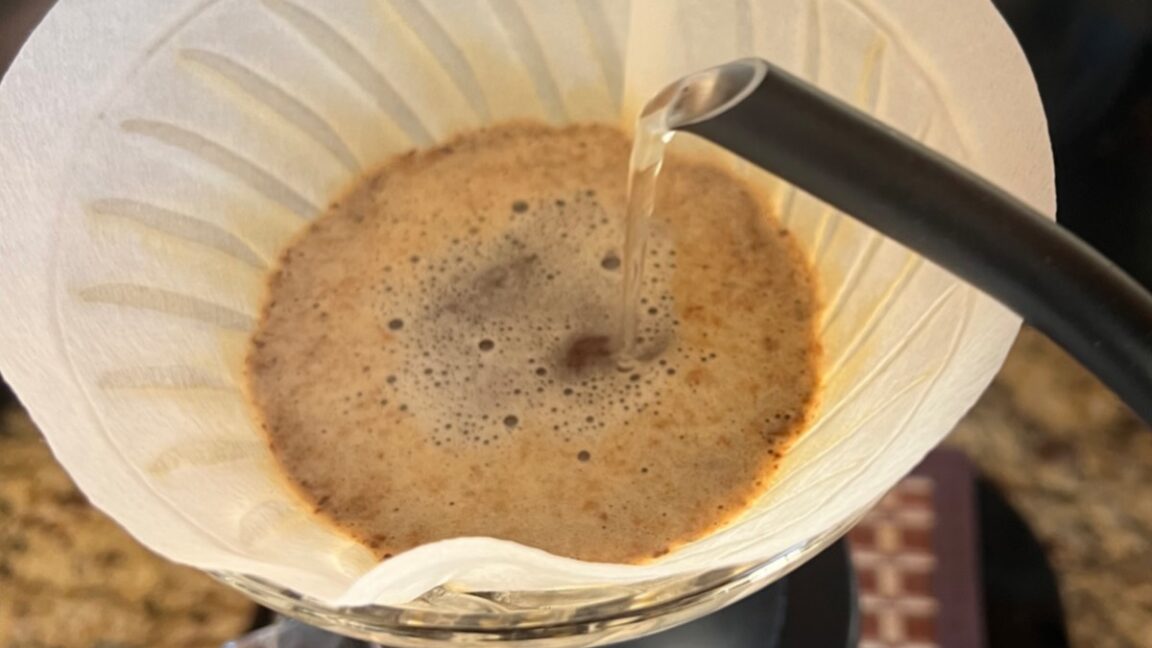Pour-over coffee is made by flowing a strong, laminar water jet through a bed of ground coffee beans.
Coffee is one of the most popular beverages in the world, counting many scientists among its fans. Naturally those scientists are sometimes drawn to study their beloved beverage from various angles with an eye toward achieving the perfect cup.
While espresso has received the lion's share of such attention, physicists at the University of Pennsylvania have investigated the physics behind brewing so-called "pour-over" coffee, in which hot water is poured over coffee grounds in a filter within a funnel-shaped cone and allowed to percolate and drip into a cup below. The trick is to pour the water from as high as possible without letting the jet of water break up upon impact with the grounds, according to their new paper published in the journal Physics of Fluids.
In 2020, we reported on a mathematical model for brewing the perfect cup of espresso with minimal waste. Many variables can affect the quality of a steaming cup of espresso, including so-called "channeling" during the brewing process, in which the water doesn't seep uniformly through the grounds but branches off in various preferential paths instead. This significantly reduces the extraction yield (EY)—the fraction of coffee that dissolves into the final beverage—and thus the quality of the final brew. That, in turn, depends on controlling water flow and pressure as the liquid percolates through the coffee grounds.
That model was based on how lithium ions propagate through a battery's electrodes, akin to how caffeine molecules dissolve from coffee grounds. Conclusion: The most reproducible thing you can do is use fewer coffee beans and opt for a coarser grind with a bit less water; brew time was largely irrelevant. Three years later, the same team showed how adding a single squirt of water to coffee beans before grinding can significantly reduce the static electric charge on the resulting grounds. This, in turn, reduces clumping during brewing, yielding less waste and the strong, consistent flow needed to produce a tasty cup of espresso.
And just last month at a physics conference, scientists presented insights into the underlying physics of channeling that will further help coffee lovers achieve more consistent results when brewing espresso. They found that channeling adversely affected extraction yields but did not impact the rate at which water flows through the espresso puck.
Art of the grind

There have been far fewer studies focusing on increasing extraction yields for plain-old pour-over coffee, according to the authors of this latest paper. The fundamental elements are the coffee grounds, a smooth laminar water flow, and a funnel-shaped cone to hold the filter. The quality of the resulting cup of coffee is dependent on such variables as the amount of coffee used, the jet radius, the pour height, and the flow velocity, all of which have an impact on how the water jet interacts with the bed of coffee grounds. Ideally, you want efficient mixing to get a richer cup.
From a physics standpoint, we're talking about a complex interplay between a liquid jet and a granular bed of coffee grounds. And granular materials are prone to avalanches. While prior research has looked at water jets and granular avalanches separately, "much less is known about water jets impinging on a liquid surface with a granular material underneath," the authors wrote. "Moreover, there are relatively few studies that directly visualize the granular particles interacting with multiphase flows."
To learn more, the authors conducted several experiments. They made pour-over coffee in the lab, analyzing the coffee grounds with a high-resolution camera to get a distribution of particle size, then measuring the total dissolved solids in the brewed coffee. They also simulated this brewing process using silica gel particles as a substitute for the coffee grounds and a transparent glass funnel at a 60-degree incline as a coffee cone filter, illuminated by lasers. Once again, high-speed cameras captured the dynamics of the interplay between the gel particles and the water jets.
Based on their findings, the authors recommend pouring hot water over your coffee grounds slowly to give the beans more time immersed in the water. But pour the water too slowly and the resulting jet will stick to the spout (the "teapot effect") and there won't be sufficient mixing of the grounds; they'll just settle to the bottom instead, decreasing extraction yield. “If you have a thin jet, then it tends to break up into droplets,” said co-author Margot Young. “That’s what you want to avoid in these pour-overs, because that means the jet cannot mix the coffee grounds effectively.”

That's where increasing the height from which you pour comes in. This imparts more energy from gravity, per the authors, increasing the mixing of the granular coffee grounds. But again, there's such a thing as pouring from too great a height, causing the water jet to break apart. The ideal height is no more than 50 centimeters (about 20 inches) above the filter. The classic goosenecked tea kettle turns out to be ideal for achieving that optimal height. Future research might explore the effects of varying the grain size of the coffee grounds.
Increasing extraction yields and, by extension, reducing how much coffee grounds one uses matters because it is becoming increasingly difficult to cultivate the most common species of coffee because of ongoing climate change. “Coffee is getting harder to grow, and so, because of that, prices for coffee will likely increase in coming years,” co-author Arnold Mathijssen told New Scientist. “The idea for this research was really to see if we could help do something by reducing the amount of coffee beans that are needed while still keeping the same amount of extraction, so that you get the same strength of coffee.”
But the potential applications aren't limited to brewing coffee. The authors note that this same liquid jet/submerged granular bed interplay is also involved in soil erosion from waterfalls, for example, as well as wastewater treatment—using liquid jets to aerate wastewater to enhance biodegradation of organic matter—and dam scouring, where the solid ground behind a dam is slowly worn away by water jets. "Although dams operate on a much larger scale, they may undergo similar dynamics, and finding ways to decrease the jet height in dams may decrease erosion and elongate dam health," they wrote.
Physics of Fluids, 2025. DOI: 10.1063/5.0257924 (About DOIs).
Hope you enjoyed this news post.
Thank you for appreciating my time and effort posting news every day for many years.
News posts... 2023: 5,800+ | 2024: 5,700+ | 2025 (till end of March): 1,357
RIP Matrix | Farewell my friend ![]()
- Mutton
-

 1
1



3175x175(CURRENT).thumb.jpg.b05acc060982b36f5891ba728e6d953c.jpg)
Recommended Comments
There are no comments to display.
Join the conversation
You can post now and register later. If you have an account, sign in now to post with your account.
Note: Your post will require moderator approval before it will be visible.